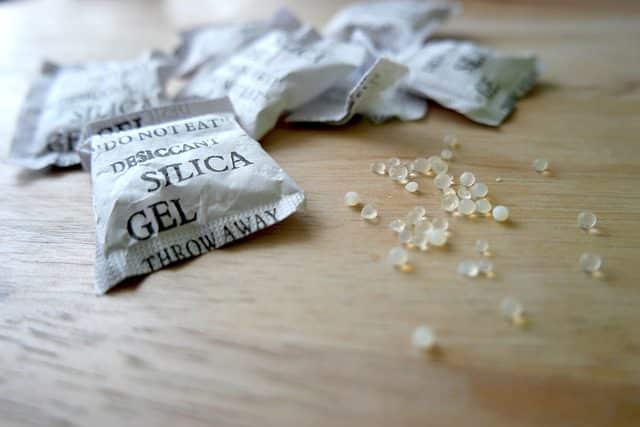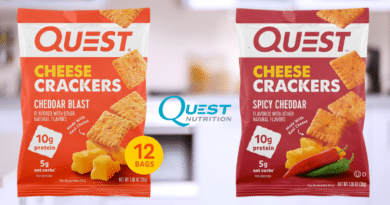The Role of Desiccant Packets in Keeping Your Supplements Fresh
How many times have you opened up a tub of your favorite supplements and found little packets inside and wondered what the heck they are? You’re not alone. In fact, most people have absolutely no clue what those little packets are and (unfortunately) throw them away, thinking it’s part of the packaging and protective seal. However, those little packets buried in your supplements are actually desiccant packets — and they’re keeping you from a whole lot of frustration and profanity.
Table of contents
Disclaimer: This article is for informational purposes only and is not meant to treat or diagnose any condition. It is recommended that you speak with your doctor before starting any exercise program, changing your daily nutrition, or adding any supplements to your regimen.
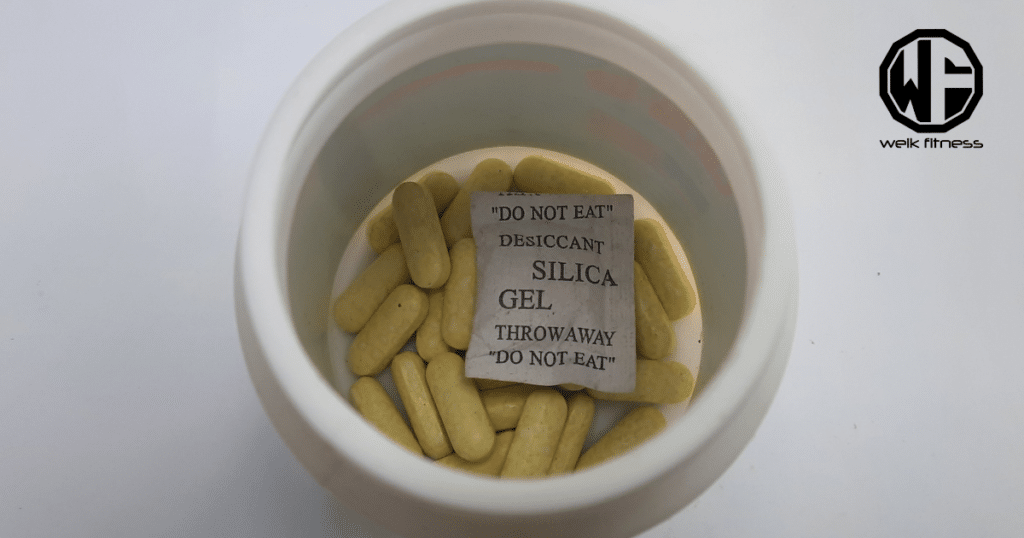
What Are Desiccant Packets?
Desiccant packets can vary in size and shape, but they all play the same role in your supplements — to keep your supplements moisture-free. When moisture, humidity, and odor get inside your supplement container, bad things can happen. These helpful packets also play a role in removing CO2 and C12 from accumulating inside your supplement bottles or tubs.
Additionally, when you factor in all the benefits mentioned above, and the role desiccant packets play, it should be noted that these packets also keep your supplements from degradation and going bad before the expiration date.
How many times have you opened a new pre-workout, and a couple of weeks in, you have yourself a solid brick that was once a delicious and mouth-watering pre-workout that fueled your training session and helped you get swole? Your hand is probably raised (so is mine). The good news is that quality manufacturers and supplement brands are now putting desiccant packets in their pills and powder bottles, and tubs to help manage moisture and prevent your supplements from going bad on you.
Related Article: Does Protein Powder Expire? If It’s Expired, Is It Safe to Use?
Nothing is more frustrating than getting ready for a grueling workout only to find your pre-workout is now a solid or starting to get clumpy where even using a knife to break it up doesn’t help. You could technically classify your rock-hard pre-workout as a deadly weapon (I do not recommend throwing it at a window).
Here’s something worth noting… desiccant packets ARE reusable (but if your supplement doesn’t come with them, they’re inexpensive like these). Once your desiccant packets become completely saturated and unable to pull/hold any more moisture, you can either throw them away and use fresh new desiccant packets, or if you’re into DIY projects, you can toss the desiccant packets on a baking sheet and put them in the oven for around 300 degrees until they dry back out and can be reused, which extends the life of your packets.
Note: Do not break open the desiccant packets, and if you notice one is torn, and the contents have spilled out into or onto your supplements, do not use or consume the product. Contact the brand or manufacturer and explain that your supplement is bad and that the desiccant packets were torn and open upon inspection of the product after purchase. It should go without saying, but I guess we need to say it because I’m sure there has been someone who did this… DO NOT eat the desiccant packets, and keep them away from small children who could eat or choke on them.
What’s Inside Desiccant Packets?
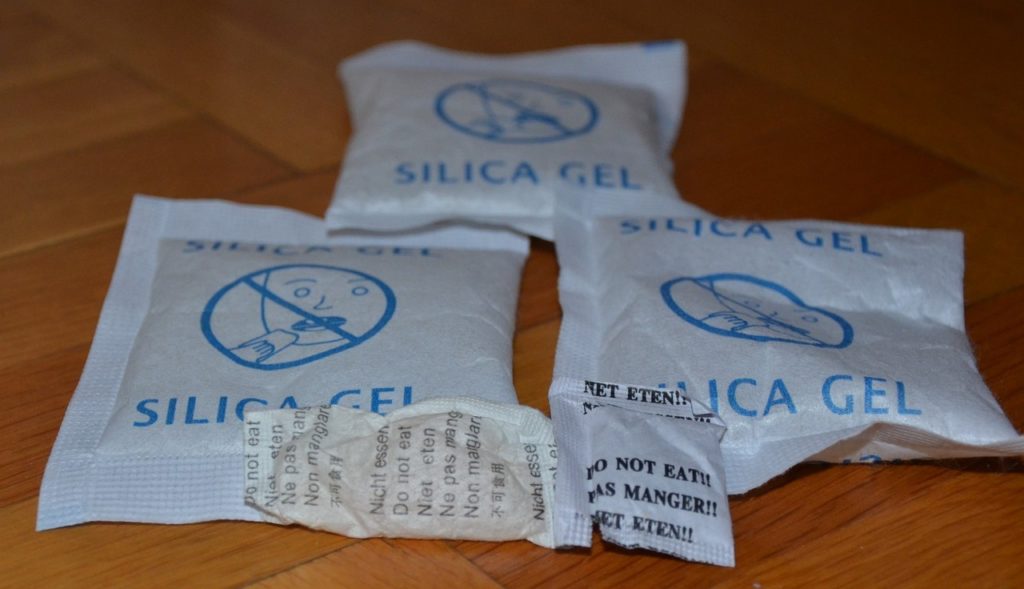
While there are multiple types of desiccant packets used in the industry and put inside supplement bottles and tubs, the main three materials commonly found and used are silica (silicon dioxide or SiO2) gel, carbon, and/or bentonite clay.
Related Article: Supplement Lawsuits Are Getting Out of Hand
When you look at some of these desiccant packets, let’s use the silica gel, for example, they contain tiny pores that have the ability to pull in and absorb any moisture that gets trapped inside your favorite supplements.
It is said that silica gel can absorb as much as 40% of its weight in moisture. Likewise, this could essentially take the humidity inside a bottle or container of supplements down by as much as 40%.
How Do Desiccant Packets Work?
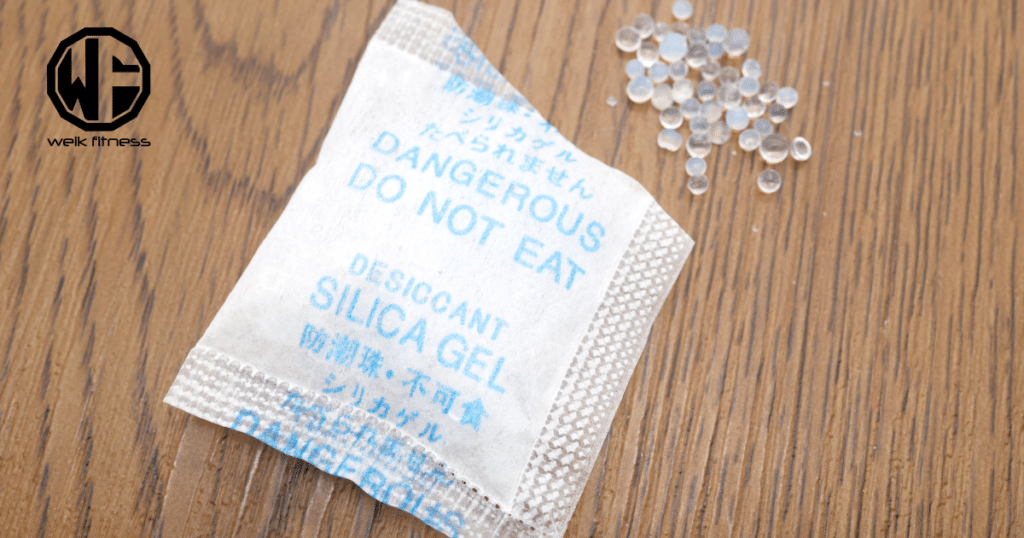
Desiccant packets work by absorbing moisture from the air around them. Here’s a more detailed explanation of how they work:
- Desiccants are hygroscopic substances that have a natural affinity for water molecules. Common desiccants include silica gel, activated alumina, calcium chloride, and zeolites.
- These substances are very porous with lots of internal surface area. When exposed to humid air, the water molecules from the air adhere to the surface of the desiccant through physical adsorption or chemical absorption.
- As the desiccant absorbs moisture, the humidity level around it decreases. This creates a small zone of dry air around the desiccant packet.
- The water molecules are tightly held within the structure of the desiccant and do not easily evaporate back into the air. This allows the desiccant to continuously absorb moisture.
- Desiccant packets are placed in enclosed spaces like food packaging to keep the contents dry and moisture-free. The desiccant absorbs any excess moisture or water vapor before it can condense and cause food spoilage.
- Different types of desiccants work at different levels of humidity. Silica gel is effective for low to moderate humidity levels. Calcium chloride works better at higher humidity.
- Over time, the absorption capacity of the desiccant can become saturated. Desiccant packets may change color to indicate they are no longer effective and need replacement.
Should You Remove Desiccant Packets from Supplements?
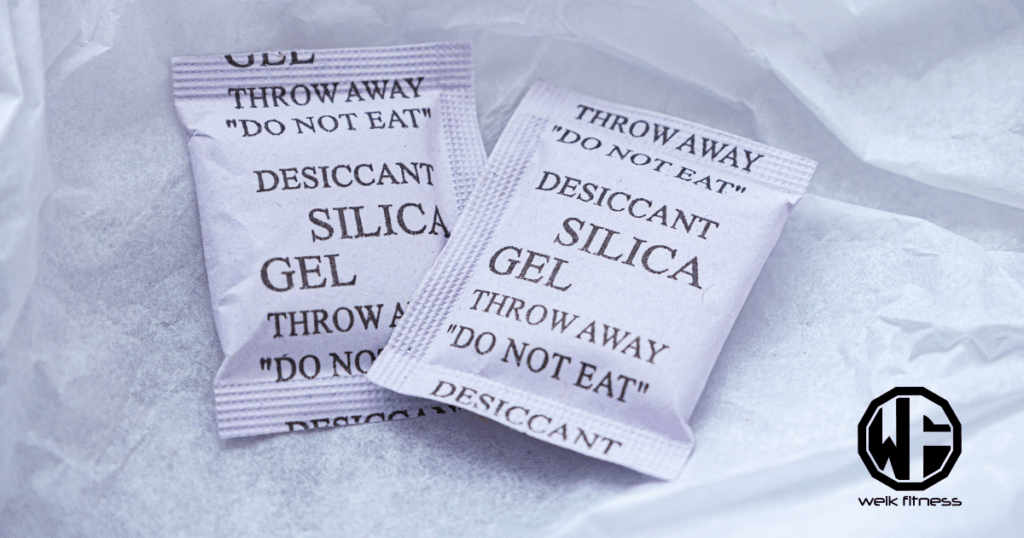
There’s some debate around whether desiccant packets should be removed from supplements or left in the bottle. Here are some key considerations:
- Purpose: Desiccants are added to supplement bottles to keep the contents dry and extend shelf life. They prevent moisture from damaging the supplements.
- Safety: Desiccant packets contain silica gel or clay which could be harmful if ingested in large quantities. However, the amount contained in a typical packet is very small and not toxic. The packets are labeled “Do not eat”.
- Moisture absorption: If the desiccant packet is removed, moisture from the air can condense inside the supplement bottle over time. This speeds up degradation.
- Recommendations: Many supplement companies recommend leaving the desiccant packets in the bottle to maintain product stability. Removing them can shorten the shelf life.
- Alternatives :Some brands use induction seals, nitrogen flushing or tighter seals instead of desiccants to protect supplements. This eliminates any ingestion risk.
- Storage: Storing supplements in a cool, dry area reduces the need for desiccants. Limited exposure to humid air prevents moisture damage.
Overall, the desiccant packets are added for good reason – to extend supplement stability. Leaving them in the bottle as recommended is generally safe. But removing them takes away some protection against degradation over time. Proper storage is the best way to keep supplements intact with or without desiccants.
Are There Disadvantages to Removing Them from Your Supplements?
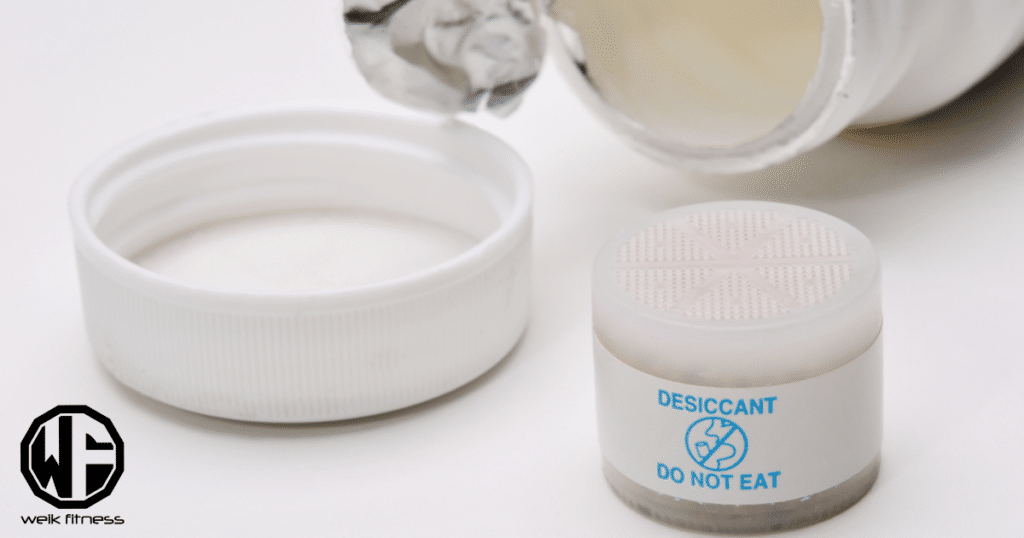
es, there are some potential disadvantages to removing desiccant packets from supplements:
- Accelerated degradation: Desiccants help protect against moisture damage and oxidation. Removing them can shorten the shelf life and accelerate degradation of supplements, especially those containing herbs, probiotics, fish oils, etc.
- Loss of potency: Exposure to humidity can cause supplements to break down more quickly. This can lead to a loss of potency and therapeutic benefit over time. Desiccants help maintain supplement potency for longer.
- Clumping/hardening: Moisture encourages ingredient clumping and hardening in supplements containing amino acids, protein powders, etc. Desiccants help keep the powder free-flowing.
- Microbial growth: Spore-forming microbes like mold and fungi can grow in moist conditions. Desiccants restrict microbial growth by keeping supplements very dry.
- Tablet disintegration: For tablet or capsule supplements, moisture damage can affect disintegration and dissolution. Without desiccants, supplements may not properly break down.
- Nutrient oxidation: Vitamins, omega-3s and other nutrients can oxidize when exposed to oxygen and moisture. Desiccants provide protection against oxidation reactions.
- Cost: Having to replace degraded supplements earlier due to moisture damage can increase costs over time. Desiccants help extend usable life.
Do Desiccant Packets Go Bad?
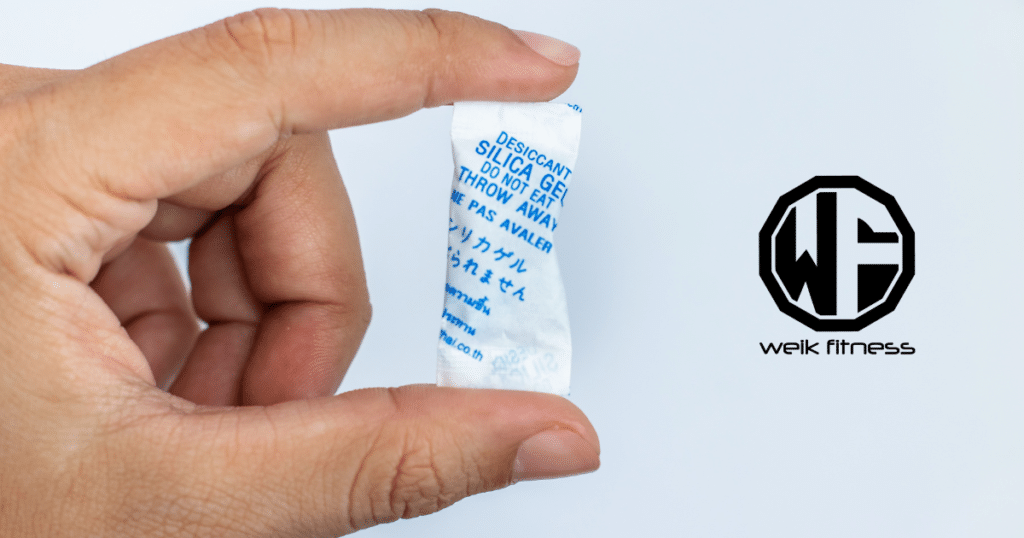
Yes, desiccant packets can eventually go “bad” and lose their moisture absorbing capabilities:
- Saturation: As desiccant packets absorb moisture over time, the active material like silica gel or clay will eventually become saturated. This limits further absorption.
- Color change: Many desiccant packets contain moisture indicator beads that change color as they become saturated. This signals the desiccant is no longer effective.
- Caking: Absorbed moisture can cause desiccant materials like silica gel to cake or solidify. This reduces exposed surface area and limits further moisture uptake.
- Contamination: Exposure to certain gases and vapors can contaminate and deactivate the desiccant material, reducing effectiveness.
- Breakdown: Some types of desiccants like calcium chloride can break down with repeated absorption-desorption cycles. The material loses absorbency.
- Temperature: High temperatures and humidity accelerate the degradation of desiccants. Absorption capacity declines more rapidly.
- Damage: Physical damage like punctures or tears to the desiccant packet also reduce moisture absorption rate and capacity.
- Expired packets: Desiccant packets have an expiration date based on expected lifespan. Absorbency declines beyond this point.
To summarize, desiccant packets lose effectiveness once saturated, expired, or damaged. Their moisture absorbing properties degrade over time with use. Changing color signals they should be replaced.
What Products Need These Packets?
The supplement industry should be fully vested in the model of using desiccant packets inside their products, but for whatever reason, some brands have not jumped on board. But in terms of what products need desiccant packets? All of them can benefit and should use them as a precautionary measure — pills, powders, and capsules. The pros outweigh the cons of not using desiccant packets.

I know first-hand what happens when you don’t use desiccant packets from my days working for a supplement brand. I was a huge advocate for them even before they were considered somewhat of a standard. The fact of the matter is, products that sit in a hot and humid warehouse that isn’t temperature and humidity-controlled can wreak havoc on supplements and turn your favorite powders into a brick, even without the seal being broken or tampered with.
Related Article: Is It Safe to Use Expired Vitamin Supplements?
Should you realize that the supplement you purchased does not have any desiccant packets in it, you can always purchase desiccant packets in bulk online at places such as Amazon.
The goal of this article isn’t meant to tell you what you should or shouldn’t do in terms of your supplement purchasing behaviors, but I would recommend that if the brand you’re using does not use desiccant packets, they are way behind with the times and are trying to cut corners to help pad their margins — it may be time to find a new brand of supplements to use.
What’s the bottom line? It’s simple. ALL supplements should utilize desiccant packets to preserve the quality of the product and prevent it from going bad.


*Disclosure: This article may contain affiliate links or ads, which means we earn a small commission at no extra cost to you if you make a purchase through these links. These commissions help support the operation and maintenance of our website, allowing us to continue producing free valuable content. Your support is genuinely appreciated, whether you choose to use our links or not. Thank you for being a part of our community and enjoying our content.
PLEASE CONSIDER SHARING THIS ON YOUR SOCIAL MEDIA TO HELP OTHERS LEARN MORE ABOUT THIS TOPIC.


